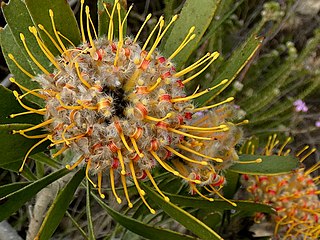
The Ixodidae are the family of hard ticks or scale ticks, one of the three families of ticks, consisting of over 700 species. They are known as 'hard ticks' because they have a scutum or hard shield, which the other major family of ticks, the 'soft ticks' (Argasidae), lack. They are ectoparasites of a wide range of host species, and some are vectors of pathogens that can cause human disease.
The Kadam virus is a tick-borne Flavivirus.

Crimean–Congo hemorrhagic fever (CCHF) is a viral disease. Symptoms of CCHF may include fever, muscle pains, headache, vomiting, diarrhea, and bleeding into the skin. Onset of symptoms is less than two weeks following exposure. Complications may include liver failure. In those who survive, recovery generally occurs around two weeks after onset.

Thogotovirus is a genus of enveloped RNA viruses, one of seven genera in the virus family Orthomyxoviridae. Their single-stranded, negative-sense RNA genome has six or seven segments. Thogotoviruses are distinguished from most other orthomyxoviruses by being arboviruses – viruses that are transmitted by arthropods, in this case usually ticks. Thogotoviruses can replicate in both tick cells and vertebrate cells; one subtype has also been isolated from mosquitoes. A consequence of being transmitted by blood-sucking vectors is that the virus must spread systemically in the vertebrate host – unlike influenza viruses, which are transmitted by respiratory droplets and are usually confined to the respiratory system.

Hyalomma is a genus of hard-bodied ticks common in Asia, Europe, and North Africa. They are also found in Southern Africa. The name is derived from Greek: hyalos (ὕαλος) crystal, glass; and omma (oμμα) eye.

Heartwater is a tick-borne rickettsial disease of domestic and wild ruminants. It is caused by Ehrlichia ruminantium - an intracellular Gram-negative coccal bacterium. The disease is spread by bont ticks, which are members of the genus Amblyomma. Affected mammals include cattle, sheep, goats, antelope, and buffalo, but the disease has the biggest economic impact on cattle production in affected areas. The disease's name is derived from the fact that fluid can collect around the heart or in the lungs of infected animals.
Tropical theileriosis or Mediterranean theileriosis is a theileriosis of cattle from the Mediterranean and Middle East area, from Morocco to Western parts of India and China. It is a tick-borne disease, caused by Theileria annulata. The vectors are ticks of the genera Hyalomma and Rhipicephalus.
Sweating sickness is "an acute, febrile, tickborne toxicosis characterized mainly by a profuse, moist eczema and hyperemia of the skin and visible mucous membranes." It affects cattle, mainly calves, mostly in southern and eastern Africa. It is caused by toxins that develop in some ticks of the Hyalomma truncatum species.

Hemolivia is a genus of the phylum Apicomplexia.

Ticks of domestic animals directly cause poor health and loss of production to their hosts. Ticks also transmit numerous kinds of viruses, bacteria, and protozoa between domestic animals. These microbes cause diseases which can be severely debilitating or fatal to domestic animals, and may also affect humans. Ticks are especially important to domestic animals in tropical and subtropical countries, where the warm climate enables many species to flourish. Also, the large populations of wild animals in warm countries provide a reservoir of ticks and infective microbes that spread to domestic animals. Farmers of livestock animals use many methods to control ticks, and related treatments are used to reduce infestation of companion animals.

Hyalomma marginatum is a hard-bodied tick found on birds including the pale crag martin. This tick has been implicated in the transmission of Bahig virus, a pathogenic arbovirus previously thought to be transmitted only by mosquitoes.
Tete orthobunyavirus is a bunyavirus found originally in Tete Province, Mozambique. It is a disease of animals and humans. Two forms, Bahig and Matruh viruses, were isolated from bird ticks including Hyalomma marginatum, but elsewhere mosquitoes and biting midges have been implicated as vectors.
Makram Nasri Kaiser (1930–1996) was a medical and veterinary acarologist who was the world's leading authority on ticks of the genus Hyalomma.
The Bhanja virus is a tick-borne virus first discovered in a tick taken from a paralyzed goat in Bhanjanagar, India in 1954. Bhanja virus in humans was first documented in 1974 when Charles Calisher was working with the virus in a lab and contracted it himself. His experience with the virus was mild and included symptoms of mild aching in muscles and joints, moderate headache, slight photophobia. The Bhanja virus is a member of the Bhanja virus serocomplex and is a member of the Bunyavirales order.

Hyalomma dromedarii is a species of hard-bodied ticks belonging to the family Ixodidae.
Tibovirus Is term is often used to describe viruses that are transmitted by tick vectors. The word tibovirus is an acronym. This falls within the superorder arthropod thus tibovirus is classified under Arthropod Borne virus (Arborvirus). For a person to acquire infection the tick must bite and feed for a sufficient period of time. The tiboviruses that affect humans are limited to within 3 families: Flaviviridae, Reoviridae, and Bunyaviridae.
Hyalomma brevipunctata, or Sharif's Indian hyalomma, is a hard-bodied tick of the family Ixodidae. It is found in India and Sri Lanka.

Leucospermum truncatum, commonly known as the limestone pincushion, is a shrub native to South Africa. The flowers are initially bright yellow but turn orange with time. Flowers can be found between August and December.
Paul Schulze was "the most important German tick taxonomist of the early 20th century." Between 1929 and 1937, he described 19 genera, 17 subgenera, 150 species and 150 subspecies of ixodid ticks. He was essentially an amateur taxonomist, working alone for most of his career, not consulting the major tick collections or collaborating with other tick taxonomists.








